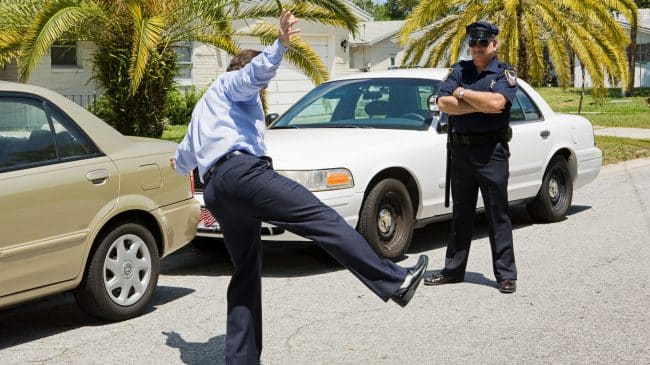Now that several states have legalized medical and recreational marijuana, police have to come up with a strategy for determining when drivers under the influence of marijuana are impaired. Obviously, in states where marijuana use is illegal, a driver with any cannabis on board is committing a crime. But for states where it is legal, levels and impairment are key to assessing whether the driver should be taken off the road. Some states rely on chemical testing alone and/or per se standards, such as with alcohol, even though blood level of cannabis is not directly correlated to impairment level. Others states rely on officers evaluating impairment via Drug Recognition Expert evaluations.
Typically, a patrol officer conducting a traffic stop of a driver who appears to be impaired looks to ascertain first whether the driver is under the influence of alcohol or not. If the impairment is more than a simple alcohol-based DUI, a Drug Recognition Expert (DRE) is summoned to the scene (in departments that have them). The DRE will do a quick roadside assessment to determine whether a full DRE evaluation at the station is necessary. The roadside assessment allows the DRE to rule out medical pathologies and gain basic information.
For example, the officer can tell a lot by looking at the pupils:
unequal—medical pathology; call an ambulance.
horizontal gaze nystagmus (HGN)—This is the involuntary horizontal jerking of the eyes, especially at the outer corners, as they track an object. When an officer asks you to keep your head straight and follow the movement of a pen or some other object, he’s probably looking for HGN. It signals alcohol or depressant use, and possibly other drug classes, but not typically marijuana. If alcohol is the only drug on board, the DRE can gauge the blood-alcohol content (BAC) roadside to determine if it matches the driver’s impairment or not. If the HGN is egregious, the DRE will look for VGN–vertical gaze nystagmus.
vertical gaze nystagmus—This is the involuntary vertical jerking of the eyes. Any substance, including alcohol, that produces HGN will also produce VGN in a high dose (varies by individual), but no drug causes VGN without HGN. Such an event would suggest a medical pathology. If alcohol is the only drug believed to be on board, this suggests a high rate of intoxication and medical intervention should be considered.
resting nystagmus—This is the involuntary jerking of the eyes horizontally and vertically when facing straight. This signals the DRE to look for other drugs on board, typically PCP, especially if the subject has a distinct chemical odor and is sweating profusely.
extreme dilation/constriction of pupils (beyond normal range)—This sign often reflects the use of stimulants (meth/cocaine) or opiates, respectively.
pulsating pupils—This is useful information for the officer, as it signals withdrawal from certain drugs and/or indicates multi-drug use.
The DRE will also check for markers of medical reasons for impairment—diabetic shock, stroke, concussion, injuries, etc. Based on this roadside assessment, if the DRE forms the opinion that drugs other than alcohol are the likely cause of impairment, it’s time to conduct a full evaluation at the station.
The full DRE evaluation is a 12-step process that must occur in controlled conditions, such as are provided at the station. It includes several physiological measures such as blood pressure and heart rate, as well as asking the subject about any prescription drug use. As well, an expanded field sobriety test (FST) evaluates divided attention, coordination and time-assessment skills—the skills specifically needed for driving. Subjects have to walk in line and turn, stand with eyes closed and estimate time, stand on one leg, and touch a finger to nose. Whether the subject fails, and if so, how they fail, correlates to impairment by different drug classes.
Cannabis has many FST “markers,” but there are also important clinical markers. For example, physiological markers for cannabis include elevated pulse, dilated pupils (in all light conditions), lack of eye convergence (you can’t cross your eyes—but some folks can’t do this anyway), rebound dilation (dilation of pupils after a light has been applied and after eyes initially constrict), bloodshot eyes, eyelid tremors when eyes are closed, and body tremors while standing.
How did DREs arrive at these markers for cannabis? Back in the 1960s, when illicit drug use, including marijuana, became popular in the U.S., LAPD traffic officers noted that heavily impaired drivers were blowing zeroes on alcohol breathalyzers, forcing officers to hand them back their keys because there was no law on the books to arrest them. A team of these LAPD traffic officers compiled lists of the correlations between physiological markers present during the psychoactive phase of drug use and chemical test results showing which drugs were in a subject’s system, and worked with medical experts to correlate drug categories with signs and symptomatology. These markers concentrate on physiological markers a subject can’t voluntarily control and present themselves only when drugs (to include alcohol) are psychoactive in the subject’s system.
From these correlations, a step-by-step evaluation process, which includes a urine or blood test, evolved. DRE officers used these evaluations to form an opinion as to the source of impairment. These opinions were confirmed by toxicology tests over 90% of the time. This does not imply a 10% error rate, as sample collection times, lab capabilities, etc. play a part, and many drugs cannot be effectively tested (some hallucinogens, designer drugs, not to mention Tide pods and other oddball drug fads). This accuracy rate allowed officers to make these arrests—taking these dramatically impaired drivers off the road—and work within the court system to prosecute these offenses. Currently, nationwide tracking allows state DRE coordinators to monitor toxicological confirmation of DRE findings, ensuring DRE accountability.
While not all cannabis users will display all the physiological characteristics (and some people have a few of these characteristics cold sober), it’s a matter of forming an opinion through the aggregation of the symptoms and signs. As my sergeant used to say, “If you have a round flat piece of bread, do you have a pizza? No. If you put tomato sauce on it, do you have a pizza? No. But when you add in cheese and pepperoni, now you have a pizza.”
The officer has to “have a pizza” to call cannabis. Rogue officers don’t live up to this standard, but there are few of them (really there are—they just get a lot of media attention, like everything else now), and there should be zero tolerance for them.
Since the evolution of DRE evaluations, NHTSA and IACP (International Association of Chiefs of Police) and other organizations have conducted studies of impaired subjects vs. controls for each drug class evaluation by DREs. Regarding marijuana specifically, here’s the best of these studies I found on cannabis markers in DRE evaluations.
These correlations are not easy to study outside of a scientific setting, as—what most people don’t realize—the number of drugged subjects encountered by police who have only one drug in their system is quite small. Almost all have at least two on board, and street addicts commonly have five or six, especially in large urban areas. Such “cocktailing” makes DRE evaluations complicated, as users on drugs with opposing signs, such as, for example, stimulants and opiates, at the same time can have normal blood pressure, pulse rates and pupil size. But are they impaired? Yes, they are. So that’s when other markers come into play.
DREs are especially important in cases of marijuana-impaired drivers, because of the nature of marijuana itself. As with other non-alcohol drugs, marijuana impairment varies tremendously by individuals, even under the same dose. As with other non-alcohol drugs, marijuana does not break down in the body in a manner that correlates with psychoactivity of the drug (alcohol is the exceptional drug in this regard, not the norm), making chemical testing results of little use in determining impairment. In contrast, with few exceptions, the signs and symptomatology of marijuana ingestion that DREs evaluate will not appear when the drug is no longer psychoactive in the subject, but can still appear in chemical testing for weeks after use. For these reasons, DRE evaluations are far more accurate in determining marijuana impairment in drivers, and police departments should make use of these highly trained officers, especially in states with legalized marijuana use.

